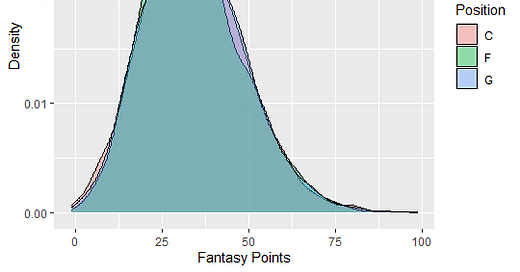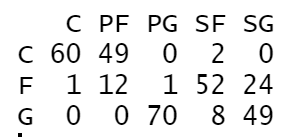There comes a point in every football season where I feel like I need a new project to get into. Fortunately, Underdog has acquiesced to this request. What has rapidly become the hands-down best platform to play NFL best ball now will be dipping its toes into the NBA streets.
Along with new NBA contests, Underdog has a $25 tournament with a $20,000 first prize. I set out to find some edges in this new game with hoops coming back in less than a month.
The Settings
Obviously it is paramount to success in any game to understand the rules. The scoring settings should look familiar.
Anyone already entrenched in NBA DFS likely recognizes this as FanDuel scoring, and that should give you some familiarity with the kinds of scores players can produce. The roster settings are extremely wide open.
These are 16 round drafts, with just six starters. In a league that is growing more and more position-less each year, Underdog has opted to go with two “guards”, two “wings”, one “big”, and a flex. With low amounts of positional specificity, this makes it easier to put together a lineup each week.
Micro-Positions
Although Underdog is going with very generalized positions, that does not mean we shouldn’t look at the micro-positions making up those roster slots. After all, roles within teams can vary great based on a player’s actual spot on the floor. This is the breakdown I came up with by matching Underdog’s positions with Spotrac (in a few cases, I did not find a cross-match, so I used Yahoo’s position).
*Note: When I downloaded the Underdog CSV, they listed the positions as guard, forward, and center rather than guard, wing, and big. This is why you see them listed G/F/C, and I will use these terms interchangably.*
As expected, almost all centers are bigs, small forwards are wings, and point guards are guards. The “tweener” positions are where things get interesting. Off-guards are sometimes guards and sometimes wings, and while most PFs are bigs, they are sometimes also wings.
These notes will be helpful later when looking at trends within positions.
Scoring and Scarcity
Given that this is a completely new format, and I myself have minimal experience in season-long NBA, I wanted to see if there were any positional edges in terms of scoring.
We don’t have any historical data on this format, but I took a look at the top-100 ranked players by Yahoo each of the past three seasons, then applied their Underdog positions to their game log data. This is what the scoring distributions look like.
The distributions almost perfectly overlap, which is both really neat and not totally surprising. If we take a look at how scoring changes by rank, we do see something worth taking note of.
Scoring is fairly consistent between positions, but we can see that the forwards (wings) experience a steeper drop-off than guards and bigs before they again normalize with the other positions. This is because some of the most dominant fantasy players over the years have been wings: Giannis Antetokounmpo, Kevin Durant, and LeBron James — among others.
This data would suggest that we should prioritize obtaining early wing(s) in drafts. A very simple scarcity-check based on early Underdog ADP backs this up.
Forwards are 33% less populated inside of the top-50 than guards, which make up 42% of the top-50, and 40% of the top-100. The wing players are also more scarce than the bigs, despite being required to start twice as many in weekly lineups.
In case you were wondering, this is how positional scoring and standard deviation shakes out if we focus solely on the six main positional sub-groups in the top 100 of Y! ranks. I am leaving out the F_PF group because it is mostly just Giannis.
In Part II of this primer, I’ll be breaking down injury rates, some micro-positional clues, and overall strategy tips. To catch all of that, subscribe to In the Aggregate for just $5/month.
For Black Friday, you can save 20% off of the subscription cost for one year by clicking the button below, or going to amicsta.substack.com/blackfriday. Spread the word!










